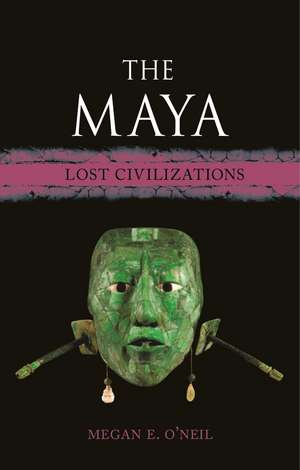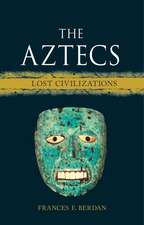The Maya: Lost Civilizations: Lost Civilizations
Autor Megan E. O’Neilen Limba Engleză Hardback – 25 dec 2022
This book reveals how the ancient Maya—and their buildings, ideas, objects, and identities—have been perceived, portrayed, and exploited over five hundred years in the Americas, Europe, and beyond.
Engaging in interdisciplinary analysis, the book summarizes ancient Maya art and history from the preclassical period to the Spanish invasion, as well as the history of outside engagement with the ancient Maya, from Spanish invaders in the sixteenth century to later explorers and archaeologists, taking in scientific literature, visual arts, architecture, world’s fairs, and Indigenous activism. It also looks at the decipherment of Maya inscriptions, Maya museum exhibitions and artists’ responses, and contemporary Maya people’s engagements with their ancestral past. Featuring the latest research, this book will interest scholars as well as general readers who wish to know more about this ancient, fascinating culture.
Preț: 117.92 lei
Nou
Puncte Express: 177
Preț estimativ în valută:
22.57€ • 24.53$ • 18.97£
22.57€ • 24.53$ • 18.97£
Carte disponibilă
Livrare economică 31 martie-14 aprilie
Livrare express 14-20 martie pentru 39.14 lei
Preluare comenzi: 021 569.72.76
Specificații
ISBN-13: 9781789145502
ISBN-10: 1789145503
Pagini: 296
Ilustrații: 60 color plates, 24 halftones
Dimensiuni: 140 x 216 x 28 mm
Greutate: 0.71 kg
Editura: REAKTION BOOKS
Colecția Reaktion Books
Seria Lost Civilizations
ISBN-10: 1789145503
Pagini: 296
Ilustrații: 60 color plates, 24 halftones
Dimensiuni: 140 x 216 x 28 mm
Greutate: 0.71 kg
Editura: REAKTION BOOKS
Colecția Reaktion Books
Seria Lost Civilizations
Notă biografică
Megan E. O’Neil is assistant professor of art history at Emory University. She is the author or coauthor of numerous publications, including Maya Art and Architecture.
Recenzii
“Useful for students and scholars needing a brief overview of the unveiling of a great civilization. Recommended.”
"Synthesizing the growing scholarship . . . into a very readable narrative, O’Neil has inverted the typical format of survey texts . . . that tend to focus almost entirely on the ancient cultures themselves and only briefly address more recent engagements with them . . . in detailing the developments of Maya scholarship from the earliest explorers through the most recent advances in archaeology, epigraphy, and ethnography, O’Neil demonstrates the inseparability of modern approaches to and understandings of the past from economic, political, and ideological considerations in the present."
“O’Neil, one of the leading art historians of the Maya, has created an essential introduction to this important civilization from deep time to the present. She grounds her new perspective on the role of colonialism and portrayals in popular culture, reframing narratives about the Maya being ‘lost’ and ‘discovered.’”
"This beautifully illustrated and meticulously researched book is a wholly new, contextual study of the Maya people of Mexico and Central America. It is a groundbreaking study for several reasons. First, it does not end with the fall of the Postclassic Maya in the sixteenth century, but continues to trace Maya culture and society’s continuous evolution through the colonial period and into the present day. Additionally, it presents a richly detailed panorama of the ways that scholarly and popular audiences in Latin America and beyond have sought to collect, display, remix, and decipher the ancient Maya since the nineteenth century. The result is a thought-provoking study of how our understandings of this ancient civilization have evolved dramatically over time, and are still being constructed today."
"More than any other introduction to the Maya, O'Neil's book draws together the fascinating story of the emergence and flowering of Maya civilization with the long history of scholarly attempts to reconstruct and understand that civilization. It is written with verve and grace, but also with a profound respect for the Maya alive today and the scholars who came before."
"Readable and full of new ideas, this is a powerful—and distinctive—book on the Maya. Engaged at every step with Maya visual culture, this is also a book of history, anthropology, and the Maya today, one that makes strong connections between the artistic efforts of the first millennium CE and life and practice in the twentieth and twenty-first centuries."


















